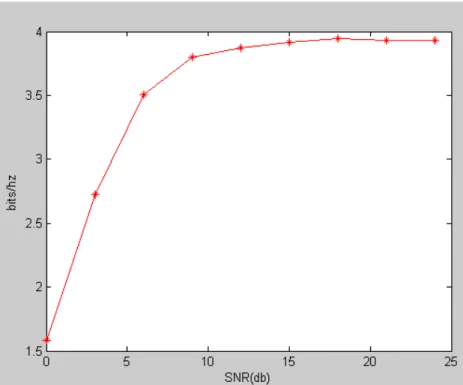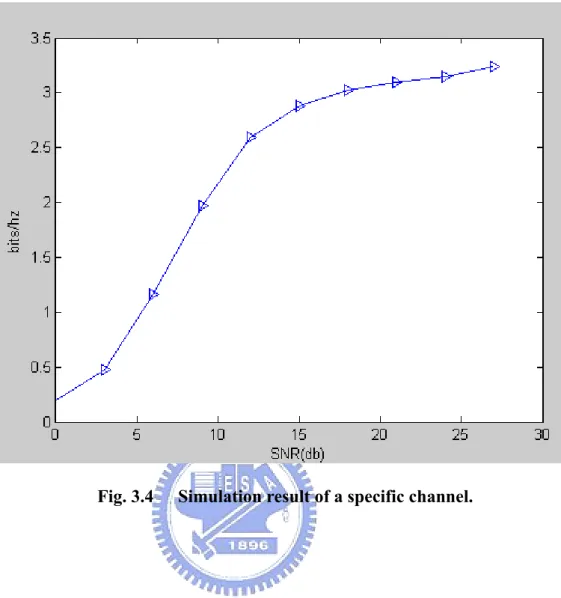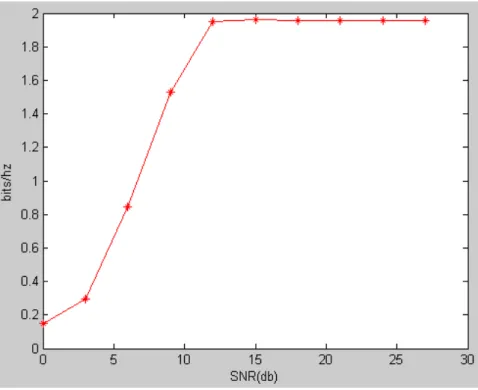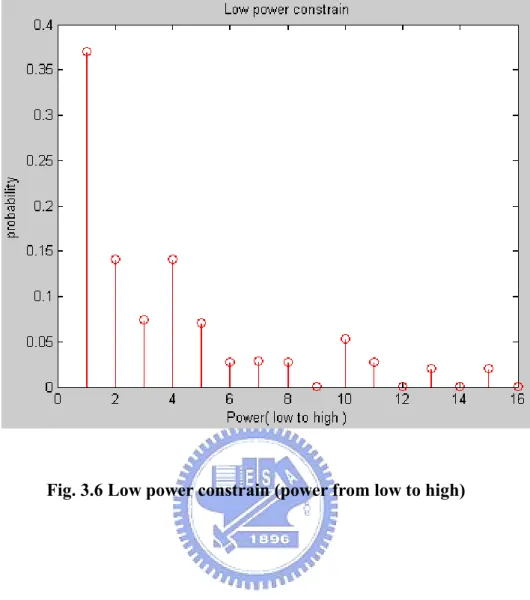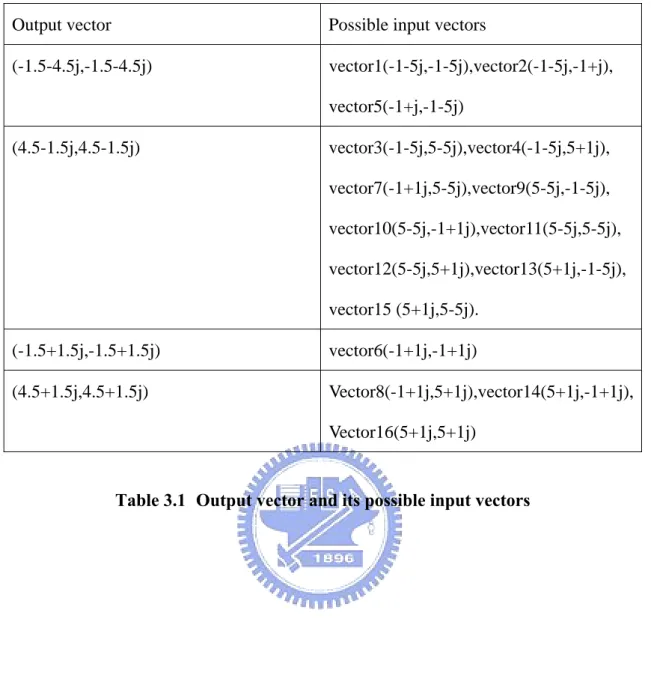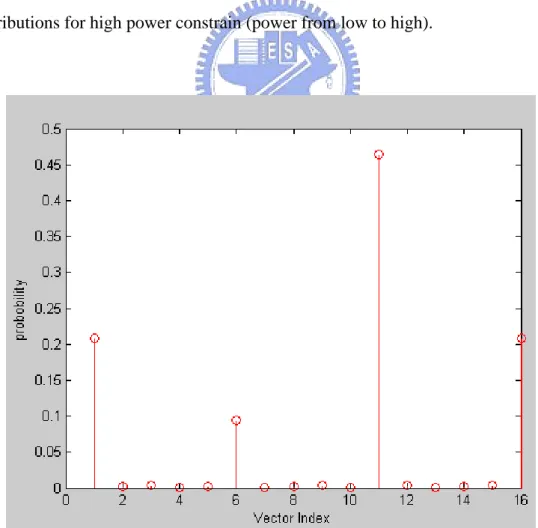1
國
立
交
通
大
學
電子工程學系 電子研究所碩士班
碩
士
論
文
量化 MIMO 系統通道容量之研究與分析
Research and Analysis in Channel Capacity of
Quantized MIMO System
研 究 生:黃 俞 榮
指導教授:桑 梓 賢 教授
1
量化 MIMO 系統通道容量之研究與分析
Research and Analysis in Channel Capacity of Quantized
MIMO System
研 究 生:黃俞榮 Student:Yu-Rong Huang
指導教授:桑梓賢 教授 Advisor:Tzu-Hsien Sang
國 立 交 通 大 學
電子工程學系 電子研究所碩士班
碩 士 論 文
A ThesisSubmitted to Department of Electronics Engineering & Institute of Electronics
College of Electrical and Computer Engineering
National Chiao Tung University
in Partial Fulfillment of the Requirements
for the Degree of
Master
in
Electronics Engineering April 2009
Hsinchu, Taiwan, Republic of China
I
量化 MIMO 系統通道容量之研究與分析
研究生:黃俞榮 指導教授:桑梓賢 教授
國立交通大學
電子工程學系電子研究所碩士班
摘要
多重輸入多重輸出(MIMO)系統在過去數年,已被證實擁有許多好處,其中最主要的好處為增加頻寬效益(spatial multiplexing)和對抗通道衰減(spatial diversity),但
過去對於 MIMO 系統的研究, 甚少考慮接收端量化的問題,在實際的應用上,發射
及接收的信號都是離散訊號。在這篇論文中,我們主要研究接收訊號經過量化
後,MIMO 系統的通道容量,並且考慮簡單的 Relay Channels。
我們首先提出在傳送訊號有功率限制的情況下,且接收訊號經過量化的通道 容量計算演算法,並且經由分析其最佳輸入信號的機率分布,說明且驗證演算法的 正確性,接著用我們所提出的演算法模擬在不同的 MIMO 架構中所得到的通道容 量且說明其結果,並且在傳送天線數以及調變信號固定的情況下,討論 AGC 使其 可以得到最大的消息量。最後,我們分析簡單的 relay channel 經過量化後的通道容 量。
II
Research and Analysis in Channel Capacity of Quantize
MIMO System
Student:Yu-Rong Huang Advisor:Tzu-Hsien Sang
Department of Electronics Engineering & Institute of Electronics
National Chiao Tung University
ABSTRACT
In the past few years, MIMO systems were already proven to have many
advantages. The main advantages are spatial multiplexing and spatial diversity. In the
past research, few have considered the problem of discrete signals at the transmitters
and receivers; in this thesis, we study and analyze the capacity of quantized MIMO
systems and consider the case of simple relays.
We propose an algorithm that can calculate Discrete-input and Quantized-output
channel capacity with input power constraint and analyze the optimal input distribution.
Then we run the algorithm to calculate channel capacity of different MIMO scenarios
and explain the simulation results. Proper AGC scheme is also used to get the
maximum information rate. Finally we consider simple relay channels and the
III
誌
謝
在這將近三年的研究所生涯中,學習了不少研究的方法與做人處事的道理。首 先要感謝指導教授桑梓賢老師,除了專業上的指導與幫助,有時也會給予我一些 思考方向上的激盪,使我更可以用不同的角度去思考問題。另外研究室的欣德學 長也在有問題疑惑時,給予我很大的幫助,同學宇峰、建男,以及各位學弟的兩 年同窗生活,除了解決研究上的問題外,也讓我的研究生活多采多姿。最後要感 謝我的父母親對我的支持與栽培,讓我的學生生涯畫下個句點。IV
Contents
Chapter 1 Introduction ... 1 1.1 Motivation ... 1 1.2 Literature Review ... 2 1.3 Purpose Of Research ... 8Chapter 2 An Algorithm for computing the capacity of Discrete Input and Discrete Output MIMO channel with input power constraint ... 9
2.1 Quantized MIMO System ... 9
2.2 Algorithm ... 11
2.2.1 Algorithm Research ... 11
2.2.2 Interval halving procedure ... 13
2.2.3 Newton-Raphson procedure ... 14
2.2.4 Algorithm Convergence ... 14
Chapter 3 Simulation Result ... 15
3.1 Discrete-input and discrete-output MIMO Rayleigh flat-Fading channels ... 15
3.2 The maximum information rate about the discrete-input and discrete-output MIMO channel ... 17
3.3 Optimal input vector distribution for different input power constraint ... 20
V
3.3.1 Low power constraint ... 20
3.3.2 High power constraint ... 26
3.4 AGC to achieve the channel capacity ... 28
Chapter 4 Simple Relay Case ... 30
4.1 Introduction ... 30
4.2 Basic Memoryless Forwarding Strategies ... 31
4.2.1 Demodulate And Forward ... 31
4.2.2 Amplify And Forward ... 31
4.3 Simulation Results ... 32 Bibliography 36
VI
List of Figures
Fig. 1.1 Digital input and continued output AWGN channel model [4]…….2
Fig. 1.2 An uniform quantizer………3
Fig. 1.3 Simulation of 4X4 MIMO,4-QAM modulation. Result for different resolution of quantization is shown [7]………5
Fig. 1.4 Quantized MIMO system model [7]………5
Fig. 2.1 Quantized MIMO system model [7]………..10
Fig. 3.1 Simulation Results………...16
Fig. 3.2 All possible transmit signal vectors in 2X2 quantized MIMO system………18
Fig. 3.3 Quantized signal vectors at the receiver………18
Fig. 3.4 Simulation result of a specific channel………...19
Fig. 3.5 Simulation result for low input power constraint……….23
Fig. 3.6 Low power constrain (power from low to high)………24
Fig. 3.7 Optimal input distribution for high power constraint……….26
Fig. 3.8 High power constrain (power from low to high)………..27
Fig. 3.9 Different AGC……….29
Fig. 4.1 Elementary Relay Channel……….30
Fig. 4.2 Different Parallel Relay………...33
VII
Fig. 4.4 Different Relay Strategies………..34
Fig. 4.5 Different Received Antenna………..34
Fig. 4.6 Different Combination………..35
VIII
List of Tables
Table 1.1 Literature summary………7 Table 3.1 Output vector and its possible input vectors……….25
1
Chapter 1
Introduction
1.1 Motivation
Channel capacity, a fundamental concept in information theory, was introduce by
Shannon [1] to specify the asymptotic limit on the maximum rate C at which
information can be reliable conveyed by the channel. Any coding scheme that
superficially appears to operate at a rate higher than C will cause enough data to be
lost because of uncorrectable channel errors so that the actual information rate is not
to be greater than C.
In [1], when computing the channel capacity the assumption is made that the
channel inputs and the channel outputs can be treated as continues random variables.
Since the DSP hardware used in digital modems utilizes a finite signal set (channel
input are modulation signals, such as QAM signals), and channel output are quantized
signals, it is clear that the channel inputs and the channel outputs are not Gaussian
random variables and the Shannon bound is not exact. So our research motivation is
to propose an algorithm to modify the Shannon bound in the practical digital channels,
2
1.2 Literature Review
The problem of obtaining the capacity of a discrete-input (fixed input
constellations) and quantized-output (the output signal is quantized by
quantizer )MIMO Rayleigh flat-fading channel has been preceded by such work as
[1], in which Shannon calculated the capacity of an AWGN channel and showed that
this capacity is achievable by a Gaussian input distribution. Arimoto [2] and Blahut
[3] derived a numerical method for computing the capacity of discrete memoryless
channels, but their algorithm did not support input power constraint. In [4], the
Blahut-Arimoto algorithm is modified to incorporate an average power constraint,
and is used to compute the capacity of discrete-input and continuous-output (output
signals are not quantized) channel, and also the convergence is proved. The channel
model in [4] is shown in Fig. 1.1.
Fig. 1.1 Digital input and continued output AWGN channel model [4].
3
calculates the capacity of a discrete-input and continuous-output channel) to
calculate the capacity of a MIMO Rayleigh flat-fading channel, which is also
discrete-input and continuous-output channel. The algorithm becomes very
computationally complex when the number of transmit antennas and signal set size
grow; so the author makes a postulation that the MIMO channel is independent
across antennas and dimensions (real dimension and imaginary dimension). Base on
the postulation, the author proposed a new algorithm which drastically reduces the
computation cost (for example, for 64-QAM constellations and three transmit
antennas, a total of 262143 variables are evaluated in the old algorithm, while only 7
variables in the new algorithm).
In [6], Obianuju Ndili and Tokunbo Ogunfunmi discovered that the Shannon
limit does not exist in modern communication systems (because of the DSP
hardware used in digital modems utilizes a finite signal set), so they proposed the
constrained Blahut-Arimoto algorithm to calculate the channel capacity with
discrete-inputs (the input signals has not been modulated) and quantized outputs (the
output signals was quantized by quantizer, which was shown in Fig. 1.2), and
extended their algorithm to calculate the capacity of MIMO channels, but they did
not prove the convergence of their algorithm.
4
In [7], the author pointed out a question, a 64-QAM modulated signal received
over a time-dispersive SISO (one transmit antenna and one receive antenna) channel
with four multi-path components can very well be quantized by a 8 bit ADC
(4*64=256,log 256 =8), which is sufficiently large for the modem to operate close to 2
channel capacity. However, the reliance on fine ADC granularity easily becomes
unjustified as soon as MIMO systems come into play. Consider for instance two data
streams (two transmit antenna) of 64-QAM modulated signals received over a
time-dispersive MIMO channel with four multi-path components. Now we need at
least 14 bit (log (4 * 64 * 64)2 =14) of resolution in order to obtain a fine granular quantization at each receive antenna. With increasing number of transmit antennas,
the ADC resolution needed for fine granular quantization soon becomes infeasible in
practice. But in their simulation (which is shown in Fig. 1.3), they showed that even
coarse quantization leads to channel capacities which are surprisingly close to the
ones obtainable with fine-granularity quantization. Their system model is shown in
Fig. 1.4, where the transmit antennas transmit digital signal (such as QAM and PAM),
and receive antennas quantized the received signals individually. Their method
calculated the channel capacity by calculating the mutual information between X and
Y (X and Y are vector), and letting the input distribution be uniform, shown in (1.1),
so in their simulation, they did not get the optimal input distribution.
1 1 1
1
[ |
]
1
[ | ] * ln
[ | ]
M M Q k j ipr yi xk
M
C
pr yi xj
M
pr yi xj
= = == −
∑
∑ ∑
(1.1)5
Fig. 1.3 Simulation of 4X4 MIMO,4-QAM modulation. Result for different resolution of quantization is shown [7].
6
According to these literatures, we classify the channel into four types.
z Continuous-input and continuous-output
The channel input is an analog random variable, and the channel output is
also an analog random variable.
z Continuous- input and discrete-output
The channel input is an analog random variable, and the channel output is a
discrete random variable (the output signal is quantized by a quantizer).
z Discrete-input and continuous-output
The channel input is a discrete random variable (the input signal is a
modulation signal), and the channel output is an analog random variable.
z Discrete-input and discrete-output
The channel input is a discrete random variable (the input signal is a
modulation signal), and the channel output is also a discrete random variable (the
output signal is quantized by a quantizer).
In the end of this section, we summarize in Table 1.1 the different channel
7
Channel model Literature Contribution
Continue input continue
output
[1] Assume channel input and
channel output are
Gaussian random
variables, we can obtain
the Shannon capacity
bound for an AWGN
channel
Continue input discrete
output
No No
Discrete input continue
output
[4] [5] Propose an algorithm to
calculate channel capacity
with input power
constraint, and extend the
algorithm to calculate
MIMO Reyleigh flat
fading channel.
Discrete input discrete
output
[2] [3] [6] [7] Point out the question
about quantized MIMO
system with coarse
quantization, and propose
an algorithm to calculate
the capacity.
8
1.3 Purpose Of Research
In the previous section, we see that discrete-input and discrete-output channel
model suits digital communication systems, but there is not an algorithm to calculate
this channel capacity with input power constraint and a convergence proof (in [6], the
authors proposed an algorithm, but they can not prove the convergence of the
algorithm. In our simulations, we found case where their algorithm fails to converge.).
Our purpose of research is to propose an algorithm, which can calculate the
discrete-input and discrete-output channel capacity with input power constraint, and
guarantee the algorithm convergent, and the algorithm is extended to MIMO cases.
We use the algorithm to study the optimal input distribution with different input
power constraint. In the end, we hope to use the algorithm to study simple relay
9
Chapter 2
An Algorithm for computing the
capacity of Discrete Input and
Discrete Output MIMO channel
with input power constraint
2.1 Quantized MIMO System
Let us consider the quantized MIMO systems in Fig. 2.1, where nT transmit
antennas are connected to nR receive antennas by the channel matrix H∈CnT nR* ,
which is assumed to be completely known to the transmitter and receiver. Because of
knowing the channel state at the transmitter, we can get the optimal input distribution
which is fitted the input power constraint ( * 2
i
Pi i =Pav
∑
X ) to approach the channel capacity. At every transmit antenna, the input signal ( ,x x1 2,...,xnT) is the modulation signals (such as PAM and QAM), and the received signal is perturbed bysamples ( ,v v1 2,...,vnR) of complex, circularly symmetric, additive, white Gaussian noise of zero mean and variance of σv2/2 in its real and imaginary part, respectively,
yielding total noise power σv2. The receive signal is split up into real-part and
10
output the quantized signals (y y1, 2,...,y2nR). Let us collect the input and output signals into vector
X=[ ,x x1 2,...xnT]T∈M (2.1)
Y=[ ,y y1 2,...y2nR]T ∈Q (2.2) Where M is a finite set containing all possible modulated transmit vector X,
while Q is a finite set containing all possible quantized receive vectors Y. Let us
write the input-output relationship of the quantized MIMO system as
Y=Quantized (HX+V) (2.3)
The individual quantizer is defined by their input-output relationship as
Quantized(r ) =q iff i l qi( )< ≤ri u qi( ) (2.4) Where q is the output of the quantizers when its input ranges between a lower limit
( )
i
l q and an upper limit u q , and these limits define the quantization interval for i( )
which the quantizers outputs the value q. Here we use the uniform quantizers in our
simulation.
11
2.2 Algorithm
2.2.1 Algorithm Research
Our goal is to find PX( )⋅ which maximize the information rate I(X;Y|H). Here
I(X;Y|H) is the mutual information between channel input and channel output
assuming the transmitter and receiver knows the channel matrix H.
The discrete-input and discrete-output channel capacity computation problem is stated
as follows:
Find the pmf (probability mass function) that satisfy the following equation
* P ( ) ( ) arg max I( ) P ⋅ ⋅ = X X X;Y | H (2.6)
The maximization in (2.6) is taken under the following set of constraint.
( * i H av MP P ∈ ≤
∑
X X X )* Xi i Xi input power constraint (2.7)( ) 1
i M
P
∈ =
∑
X X Xi (2.8)Finally, we wish to evaluate C (the discrete-input and discrete-output channel
capacity), defined as
C = I(X; Y |H)|PX( )⋅ =PX*( )⋅ (2.9) An algorithm computing the discrete-input and continuous-output channel
capacity has been proposed in [6]. We can regard the discrete-output as a special case
of the continuous-output. With the idea, we propose a discrete-input and discrete-
output version for computing the quantized MIMO channel capacity. We state as
follows.
12
Step1: Initialization
z PX( )⋅ is chosen as any valid pmf over X=[ ,x x1 2,...xnT]T (2.10) Step2: Expectation
z For all Xi∈M , compute
[ ( )log (2 ( ))] ( ) i P T E P P = X|Y i Y X|Y i X i X | Y X | Y X (2.11) Step3: Maximization
z For all Xi∈M , compute
∑
H i i i H k k k T +λX X x i M T +λX X k=1 2 P (X ) = 2 (2.12)z Where λ is chosen to satisfy
∑
T H i i M T +λX X H av i i i=1 (P - X X )* 2 =0 (2.13) Repeat step2 and step3 untilPX( )⋅ converges, and we can getPX*( )⋅ .In step2, the value T can be determined from the probabilityi P (Y | X) . When Y|X
given H and X, Y~N (HX, 2
v
σ I), thus knowing the quantization levels and appropriate
decision regions, the complementary error function can be used to compute
Y|X
P (Y | X) .
In step3, λ is chosen to satisfy the specific equation, and we introduce two methods in next two sections.
13
2.2.2 Interval halving procedure
Interval halving procedure is an efficient method for solving equation f(x) =0.
The requirements for using this method is that there are two values x and 1 x that 2
satisfy f(x )f(1 x ) <0 .Since f(2 x ) and f(1 x ) have opposite signs, we know by the 2
intermediate value theorem that there exists a solution x% and that x1≤ ≤x% x2, and with only n+1 function evaluations we can find a shorter interval of length
1 2 2
n
x x
ε = − −
that contains x%, the procedure was described as follows.
Input: x ,1 x , f(x),2 ε (tolerance error)
Output: A solution to the equation f(x) =0 that lies in an interval of length <ε Repeat Set x = (3 x +1 x )/2 2 If f (x ) f (3 x ) <0 Then 1 Set x =2 x 3 Else Set x =1 x 3 End If Until x1−x2 <2ε
14
2.2.3 Newton-Raphson procedure
Newton’s method is perhaps the best known method for finding the roots of the
real-value function. Newton’s method can often converge quickly, especially if the
iterations begin sufficiently near the desired roots.
Given a function f(x) and its derivative f’(x), we given a first guessx , and a 0
better approximation is 0 1 0 0 ( ) '( ) f x x x f x = − (2.14) We continue this process and can get the roots of the equation.
2.2.4 Algorithm Convergence
In this algorithm, we regard the discrete-output as the special case of the
15
Chapter 3
Simulation Result
3.1 Discrete-input and discrete-output MIMO
Rayleigh flat-Fading channels
In this section, we use the algorithm to simulate the discrete-input and
discrete-output MIMO Rayleigh flat-fading channels. Two transmit antennas and
two receive antennas (2X2 MIMO) are used, and at each transmit antenna, 4-QAM
signal is transmitted, and at each receive antenna, a 3 bit quantizer is used. One
thousand channels are randomly generated and the ergodic channel capacity is
calculated through averaging. We show the simulation result in Fig. 3.1 (a).
Fig. 3.1 (a) shows a typical simulation. The capacity is saturates at high SNR
because of the modulation scheme. Two antennas transmit independent signals, so the
maximum capacity of this scheme is 4 bits/channel use (2*log (4) =4). We show 2X1 2
16
Fig. 3.1 (a) 2X2 MIMO, 4-QAM Modulation, 3 bit Quantizer
Fig. 3.1 (b) 2X1 and 2X2 MIMO, 4-QAM Modulation, 3 bit Quantizer
17
3.2 The maximum information rate about the
discrete-input and discrete-output MIMO
channel
Quantizing the signal at the receiver causes of the loss of information rate. If we
transmit two independent 4-QAM signals at two antennas, and we can distinguish 16
(4*4=16) different signal vectors (which has two elements, and each element is
4-QAM signal), then the information rate is 4 bits/channel use. If we quantize the
receive signals by quantizers, we may not distinguish the all difference at the receiver
and get the maximum information rate. To explain this, we show all combination of
two antenna and modulation signal (here we use a special 4-QAM signal, which real
part is -1 and 5, and imagery part is -5 and 1) in Fig 3.2. We generate a channel
randomly, then all the possible transmit signal vectors pass the channel and are
quantized at the receiver, which was shown in Fig 3.3. In Fig 3.3, we can only
distinguish 12 different signal vectors at the receiver, so the maximum information
rate is 3.58 bit/channel use (log (12)2 =3.58). We run the algorithm, and show the simulation result in Fig 3.4, in which we see that the channel capacity does not exceed
18
Fig. 3.2 All possible transmit signal vectors in 2X2 quantized MIMO system.
19
20
3.3 Optimal input vector distribution for different
input power constraint
In this section, we analyze the optimal input vector distribution with different
input power constraint in discrete-input and discrete-output MIMO Raleigh flat fading
channel. In our simulation, in order to observe the relationship between the power
constraint and optimal input distribution, we use a special 4-QAM signal (which is the
same in section 3.1). We analyze the optimal distribution with low power constraint in
3.3.1, and analysis high power constraint in 3.3.2.
3.3.1 Low power constraint
In this section, we analyze the optimal input vector distributions with low power
constraint. We constrain the average input power 25 and show all possible transmit
vector in Fig 3.5(a), and these transmit vectors pass a special channel is shown in Fig
3.5(b). In Fig 3.5(b), we see that we can only distinguish 4 different vectors (we circle
in different color), so the maximum information rate is 2 bits/channel use
(log (4)2 = ). We run the algorithm and show the simulation result in Fig 3.5(c). In 2 3.5(c), we see that the channel capacity is saturate at 2 bits/channel use. This result
conforms to our anticipation. We show the optimal input vector distribution in high
SNR in Fig 3.5(d). We analyze these distributions as follows.
In Fig 3.5(b), we see that we can only distinguish 4 different signal vectors,
21
(4.5+1.5j,4.5+1.5j).
When we receive the vector (-1.5-4.5j,-1.5-4.5j), the transmit vector may be one
of the three vectors (vector1 (-1-5j,-1-5j), vector2 (-1-5j,-1+j), vector5 (-1+j,-1-5j)).
We summarize the relationship between the output vector and its possible input
vectors in Table 3.1. From this table, we see that we receive the vector
(-1.5+1.5j,-1.5+1.5j) only when vector6 is transmitted, and vector6 has the lowest
power 4(12+ + + = ), so that we see the probability of vector6 is the most in 12 12 12 4 Fig 3.5(d). The three vectors (which are vector1, vector2 and vector5) are transmitted,
then we can receive the vector (-1.5-4.5j,-1.5-4.5j), but the vector2 and vector5 have
the equal power 28, smaller than the power 52 of vector1, so that we see the
probability of vector2 and vector5 are equal, and bigger than vector1. We can analysis
the other distribution in Fig 3.5(b) by the same method. Fig 3.6 shows typical optimal
22 (a)
23 (c)
(d)
24
25
Output vector Possible input vectors
(-1.5-4.5j,-1.5-4.5j) vector1(-1-5j,-1-5j),vector2(-1-5j,-1+j), vector5(-1+j,-1-5j) (4.5-1.5j,4.5-1.5j) vector3(-1-5j,5-5j),vector4(-1-5j,5+1j), vector7(-1+1j,5-5j),vector9(5-5j,-1-5j), vector10(5-5j,-1+1j),vector11(5-5j,5-5j), vector12(5-5j,5+1j),vector13(5+1j,-1-5j), vector15 (5+1j,5-5j). (-1.5+1.5j,-1.5+1.5j) vector6(-1+1j,-1+1j) (4.5+1.5j,4.5+1.5j) Vector8(-1+1j,5+1j),vector14(5+1j,-1+1j), Vector16(5+1j,5+1j)
26
3.3.2 High power constraint
In this section, we constrain the input average power 70 (high input power
constraint), and the other settings are the same with section 3.3.1. We run the
algorithm and show the optimal input vectors distributions in Fig 3.6. When we
transmit one of the three vectors (which are vector8, vector14 and vector16), we can
receive the vector (4.5+1.5j,4.5+1.5j). The vector16 has the most power of the three
vectors, so we see that the probability of vector16 is the most. We can analysis the
other distribution in Fig 3.7 by the same method. Fig. 3.8 shows typical optimal
distributions for high power constrain (power from low to high).
27
28
3.4 AGC to achieve the channel capacity
In our simulation, we discover that when we fix the antenna and modulation
scheme, the AGC dominate the channel capacity. We show the different AGC in Fig.
3.9 and we can tune the AGC until achieve the maximum information rate.
29
(b) From -3 to 3
30
Chapter 4
Simple Relay Case
4.1 Introduction
Now, we want to use our algorithm to study cooperative communication and we
only consider simple cases. We start with the elementary relay channel model as
shown in Fig. 4.1, in which a single relay R assists the communication between the
source S and the destination D. There is no direct link between the source and the
destination.
Fig. 4.1 Elementary Relay Channel
Let the transmit power at the source and the relay be p and p respectively. R
At both the relay and the destination, the receive symbol is corrupted by additive
white Gaussian noise of unit power. Relay R observes r, a noisy version of transmitted
symbol x. Based on the observation r, the relay transmits a symbol f(r) which is
received at the destination along with its noise n . The relay function f satisfies the 2
average power constrain (E f r[ ( ) ]2 =PR).
r = x +n (4.1) 1
31
4.2 Basic Memoryless Forwarding Strategies
In this section, we introduce two basic memoryless forwarding strategies. We
introduce demodulate forward in 4.2.1 and amplify forward in 4.2.2.
4.2.1 Demodulate And Forward
In DF protocol, demodulation of the received symbol at the relay is followed by
modulation, the relay function for DF can be expressed as
( ) ( )
DF R
f r = P sign r (4.3) where sign(r) outputs the sign of r. Due to the demodulation process, the relay
transmitted symbol does not provide any soft information to the destination.
4.2.2 Amplify And Forward
An AF relay simply forwards the received signal r after satisfying its power constraint.
The relay function for AF can be written as
( ) 1 R AF P f r r P = + (4.4)
Evidently, with AF, the relay tries to provide soft information to the destination. A
disadvantage with this technique is that significant power is expended at the relay
32
4.3 Simulation Results
In this section, we consider simple relay case and Rayleigh flat-fading channel,
and then run our algorithm. We set the total power (source and relay) S, and noise
power N (SNR=S/N). Fig. 4.2 shows in Rayleigh flat-fading channel, more parallel
relay get the better performance. Fig 4.3 shows one relay and no relay, the
performance is similar, and two parallel relay is better. We compare two kind of
different relay strategies we describe in section 4.2, and show the simulation results in
Fig. 4.4, in which, we can see that DF get better performance in high SNR, because in
high SNR relay demodulate received signals more correct. In Fig. 4.5, we show one
relay and different received antenna simulation results, we can see that two received
antennas get better performance. In relay systems, we can trade off number of relays,
and quantization levels, and number of antennas. We show different relays and
quantization levels in Fig. 4.6, in which we see that increase one antenna, get better
performance than increase one-bit quantization. To achieve a specific performance,
we can combination different relays, antennas and quantization levels. We show
33 Fig. 4.2 Different Parallel Relay
34
Fig. 4.4 Different Relay Strategies
35 Fig. 4.6 Different Combination
36 Bibliography
[1] C. Shannon, “A mathematical theory of communication”, Bell Syst. 1984. [2] S. Arimoto, “An algorithm for computing the capacity of arbitrary discrete
memoryless channels”, 1972.
[3] R. E. Blahut , “Computation of channel capacity and rate distortion functions”, 1972.
[4] N. Varnica, X. Ma, and A. Kavcic, ”Capacity of power constrained memoryless AWGN channels with fixed input constellations”,November 2001.
[5] J. Bellorado, S. Ghassemzadeh, and A. Kavcic,”Approaching the capacity of the MIMO Rayleigh flat-fading channel with QAM constellation, independent across antennas and dimensions”.
[6] Obianuju Ndili and Tokunbo Ogunfunmi, “Achieving Maximum possible Speed on Constrained Block Transmission System”.
[7] Josef A.Nossek and Michel T.Ivrlac, ”Capacity and Coding for Quantized MIMO Systems”,2006.
37
![Fig. 1.1 Digital input and continued output AWGN channel model [4].](https://thumb-ap.123doks.com/thumbv2/9libinfo/8745426.204911/12.892.148.755.534.968/fig-digital-input-continued-output-awgn-channel-model.webp)
![Fig. 1.3 Simulation of 4X4 MIMO,4-QAM modulation. Result for different resolution of quantization is shown [7]](https://thumb-ap.123doks.com/thumbv2/9libinfo/8745426.204911/15.892.147.519.130.424/simulation-mimo-modulation-result-different-resolution-quantization-shown.webp)
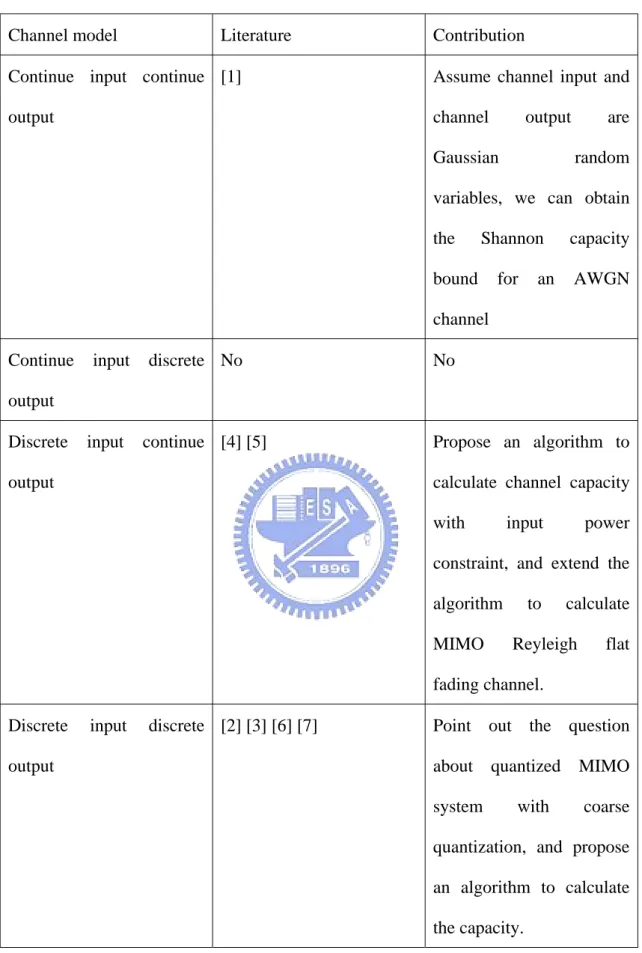
![Fig. 2.1 Quantized MIMO system model [7].](https://thumb-ap.123doks.com/thumbv2/9libinfo/8745426.204911/20.892.148.746.526.1008/fig-quantized-mimo-system-model.webp)
